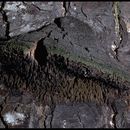en
names in breadcrumbs


Echinodontium tinctorium is a species of fungus in the family Echinodontiaceae. A plant pathogen, it is commonly known as the Indian paint fungus. Found on tree species such as grand fir (and indicating a rotten core), it can be identified by the grayish spines of its lower surface.[1]
Native Americans used the red interior as a pigment.[1] Some Plateau Indian tribes applied the fungus to skin to prevent it from chapping.[2] It is inedible.[3]
Echinodontium tinctorium is a species of fungus in the family Echinodontiaceae. A plant pathogen, it is commonly known as the Indian paint fungus. Found on tree species such as grand fir (and indicating a rotten core), it can be identified by the grayish spines of its lower surface.
Native Americans used the red interior as a pigment. Some Plateau Indian tribes applied the fungus to skin to prevent it from chapping. It is inedible.